Regenerative Design of Archaeological Sites: A Pedagogical Approach to Boost Environmental Sustainability and Social Engagement
Abstract
:1. Introduction
2. Aims
- Methodology definition.
- Case study application.
3. Methodology Definition
- Phase 1: Analysis of “understand the relationship to place”.
- Phase 2: Design to allow the “designing for harmony with place”.
- Phase 3: Education to obtain the “co-evolution” of the design.
3.1. Phase 1: Analysis
- Identification of the main characteristics of the archaeological site at landscape, urban, and building levels.
- Investigation of the relationships between physical, natural, human, and economic systems.
3.1.1. Identification
- Data collection.
- Data inventory.
3.1.2. Investigation
3.2. Phase 2: Design
- Development of key design principles and schemes.
- Execution to translate the key design principles into systemic designs, integrated plans, and construction processes.
3.2.1. Development
3.2.2. Execution
3.3. Phase 3: Education
4. Methodology Application
4.1. Phase 1: Analisys
- Identification.
- Investigation.
4.1.1. Identification
4.1.2. Investigation
4.2. Phase 2: Design
Execution
4.3. Phase 3: Educate
5. Discussion
- Deep understanding of past, current, and future evolutions of the archaeological site for identifying its risks, problems, and opportunities.
- Deep understanding of local socio-economic conditions for the success of the design project.
- Recognition and respect of history, authenticity, local identity, and meanings of cultural heritage for developing proper restoration, exhibitions, and training activities.
- Multifunctionality and flexibility as key actions for hosting a wider range of activities, visitors, and hybrid experiences.
- Improvement of accessibility and mobility connections for attracting a wider community.
- Reuse of abandoned buildings for introducing new imaginative functions.
- Reversibility and recognizability of new additions for preserving and respecting the original fabric.
- Sustainability, energy efficiency, renewable energy sources, and circular economy as fundamental principles for reducing greenhouse gas emissions.
- Green design and biophilia as criteria for boosting the social revitalization of the area.
- Use of digital technologies (e.g., serious games, virtuality, and augmented reality) for preserving and transmitting stories, legends, and intangible heritage.
- Mutual cooperation between local community and public and private sectors for contributing to the revitalization of the neighborhoods.
- Reinvestment of profits for continuative maintenance and management.
- Attractiveness of local craftsmen, creative enterprises, and innovative industries in training, research, and cultural activities on archaeological and natural heritage for creating economic spillovers (i.e., fashion, film production, etc.).
- Creation of employment opportunities in heritage and touristic sectors connected to archaeology (i.e., communication, education, tourism, food production, etc.) and development of cultural activities and events for obtaining economic benefits from visitors and local community.
- Appeal of the new intervention for incrementing local and circular tourism.
- Offering dynamic educational and social activities for residents (not only for tourists).
- Despite these aspects seeming common in a professional architectural design project, they are not usual for high educational design approaches [72]. The students learnt to create complex connections among different disciplinary fields in a critical way, understanding that urban planning and architecture needs a “living systems approach” [27] based on a deep knowledge and a positive integration among built, natural, social, and economic systems [26,28]. Some ideas are common to the concept of “regenerative heritage”, such as improvement of flexibility, hybridization, accessibility, and mobility connections [31]. Others relate to the concept of “regenerative design”, such as the deep knowledge of heritage, built, and natural systems as well as of socio-economic conditions [25,27]. Other ideas pertain to the concept of “restorative heritage”, such as the adaptive reuse of heritage, the creation of creative industries, circular tourism, and employments opportunities [30,31]. Finally, other ideas refer to “biophilia”, such as the use of green design for regenerating a semi-abandoned area [25]. Otherwise, the “biomimetic approach” [25,26] was not successful, as students prefer the recognizability of the intervention and the use of digital technologies for creating new experiences and products [33,36]. Furthermore, codesign techniques were fundamental for inspiring new ideas [34,37,38].
- This methodological approach has also several innovative aspects and benefits for the design process, such as:
- Replicability of the workflow both for architectural education and practice.
- Creation of a strategic vision and transparent planning and design process.
- Logical and reasonable scheme and transnational criteria for the sustainable decision-making process.
- Simplification of complex factors facing archaeological sites and local heritage communities today.
- Synthesis and order among environmental, social, and economic information of the site.
- Bridge of traditional boundaries between social, economic, and environmental sciences and between research, practice, and policy.
- Design innovation focused on human needs and participation processes to integrate multiple and future perspectives.
- Reiteration of the evaluations during the design process.
6. Conclusions
Funding
Institutional Review Board Statement
Informed Consent Statement
Data Availability Statement
Acknowledgments
Conflicts of Interest
Nomenclature
| UNESCO | United Nations Educational, Scientific and Cultural Organization |
| EU | European |
| UN | United Nations |
| SDGs | Sustainable Development Goals |
| WBDG | Whole Building Design Guide |
| SWOT | Strengths, Weaknesses, Opportunities, and Threats |
| IDP | Integrated Design Process |
| BREAM | Building Research Establishment Environmental Assessment Method |
| LEED | Leadership in Energy and Environmental Design |
| GBC | Green Building Council |
References
- A European Green Deal, European Commission. Striving to Be the First Climate-Neutral Continent. Available online: https://ec.europa.eu/info/strategy/priorities-2019-2024/european-green-deal_en (accessed on 18 July 2021).
- United Nations (UN). Paris Climate Agreement; UN: Paris, France, 2015. [Google Scholar]
- Communication from the Commission to the European Parliament, the Council, the European Economic and Social Committee and the Committee of the Regions, A Renovation Wave for Europe: Greening Our Buildings, Creating Jobs, Improving Lives, COM/2020/662 Final. Available online: https://energy.ec.europa.eu/topics/energy-efficiency/energy-efficient-buildings/renovation-wave_en (accessed on 8 February 2023).
- The European Commission, New European Bauhaus. Available online: https://europa.eu/new-european-bauhaus/index_en (accessed on 2 February 2023).
- European Parliament. Directive 2010/31/EU of the European Parliament and of the Council of 19 May 2010 on the Energy Performance of Buildings. Off. J. Eur. Union 2010. Available online: https://eur-lex.europa.eu/legal-content/EN/ALL/;ELX_SESSIONID=FZMjThLLzfxmmMCQGp2Y1s2d3TjwtD8QS3pqdkhXZbwqGwlgY9KN!2064651424?uri=CELEX:32010L0031 (accessed on 8 February 2023).
- European Parliament. Directive 2018/844 of the European Parliament and of the Council of 30 May 2018 amending Directive 2010/31/EU on the Energy Performance of Buildings and Directive 2012/27/EU on Energy Efficiency. Off. J. Eur. Union 2018. Available online: https://eur-lex.europa.eu/legal-content/EN/TXT/?uri=uriserv%3AOJ.L_.2018.156.01.0075.01.ENG (accessed on 8 February 2023).
- European Parliament. Directive (EU) 2018/2002 of the European Parliament and of the Council of 11 December 2018 amending Directive 2012/27/EU on energy efficiency. Off. J. Eur. Union 2018. Available online: https://eur-lex.europa.eu/legal-content/EN/TXT/?uri=uriserv:OJ.L_.2018.328.01.0210.01.ENG (accessed on 10 April 2021).
- European Parliament. Directive 2012/27/EU of the European Parliament and of the Council of 25 October 2012 on energy efficiency, amending Directives 2009/125/EC and 2010/30/EU and repealing Directives 2004/8/EC and 2006/32/EC. Off. J. Eur. Union 2018. Available online: https://eur-lex.europa.eu/legal-content/EN/TXT/?qid=1399375464230&uri=CELEX:32012L0027 (accessed on 8 February 2023).
- United Nations (UN). The Sustainable Development Agenda. Available online: https:77www.un.org/sustainabledevelopment/development-agenda (accessed on 8 February 2023).
- ICCROM (International Centre for the Study of Preservation and Restoration of Cultural Property). A guide to Risk Management of Cultural Heritage; ICCROM: Sharjah, United Arab Emirates, 2016. [Google Scholar]
- New Orleans Charter for the Joint Preservation of Historic Structures and Artefacts. Available online: www.culturalheritage.org (accessed on 8 February 2023).
- Potts, A. Executive Summary. In European Cultural Heritage Green Paper Executive Summary; Europa Nostra: The Hague, The Netherlands; Brussels, Belgium, 2021. [Google Scholar]
- United Nations Educational, Scientific and Cultural Organization (UNESCO). Hangzhou Declaration: Placing Culture at the Heart of Sustainable Development Policies; UNESCO: Hangzhou, China, 2013. [Google Scholar]
- United Nations (UN). Transforming Our World: The 2030 Agenda for Sustainable Development. Available online: https://sustainabledevelopment.un.org/content/documents/21252030%20Agenda%20for%20Sustainable%20Development%20web.pdf (accessed on 8 February 2023).
- Shetabi, L. Heritage Conservation and Environmental Sustainability: Revisiting the Evaluation Criteria for Built Heritage, Proceedings of Fabric: The Threats of Conservation; ICOMOS: Adelaide, Australia, 2015. [Google Scholar]
- Serraino, M.; Lucchi, E. Energy Efficiency, Heritage Conservation, and Landscape Integration: The Case Study of the San Martino Castle in Parella (Turin, Italy). Energy Procedia 2017, 133, 424–434. [Google Scholar] [CrossRef]
- Lucchi, E. Multidisciplinary risk-based analysis for supporting the decision-making process on conservation, energy efficiency, and human comfort in museum buildings. J. Cult. Herit. 2018, 22, 1079–1089. [Google Scholar] [CrossRef]
- Rząsa, K.; Ogryzek, M.; Kulawiak, M. Cultural Heritage in Spatial Planning. In Proceedings of the 2016 Baltic Geodetic Congress (Geomatics), Gdansk, Poland, 2–4 June 2016; pp. 85–89. [Google Scholar]
- International Council on Monuments and Sites (ICOMOS). The Paris Declaration on Heritage as a Driver of Development; ICOMOS: Paris, France, 2011. [Google Scholar]
- Mang, P.; Reed, B. Regenerative Development and Design. In Encyclopedia Sustainability Science & Technology; Springer: Berlin/Heidelberg, Germany, 2020; Volume 303, p. 2112. [Google Scholar]
- Lyle, J.T. Regenerative Design for Sustainable Development; John Wiley & Sons: Hoboken, NJ, USA, 1994. [Google Scholar]
- Wilson, E.O. Biophilia; Harvard University Press: Cambridge, UK, 1984. [Google Scholar]
- Reed, B. Shifting from ‘sustainability’ to regeneration. Build. Res. Inf. 2007, 35–36, 674–680. [Google Scholar] [CrossRef]
- Craft, W.; Ding, L.; Prasad, D.; Partridge, L.; Else, D. Development of a Regenerative Design Model for Building Retrofits. Procedia Eng. 2017, 180, 658–668. [Google Scholar] [CrossRef]
- Naboni, E.; Havinga, L. Regenerative Design in Digital Practice. In A Handbook for the Built Environment; Eurac Research: Bolzano, Italy, 2019. [Google Scholar]
- Wahl, D.C. Regenerative Design and a Science of Qualities. Netw. Rev. Sci. Med. Netw. 2016, 2, 12–14. [Google Scholar]
- Van der Ryn, S.; Cowan, S. Ecological Design; Island Press: Washington, DC, USA, 1996. [Google Scholar]
- Sanford, C. The Responsible Corporation: Reimagining Sustainability and Sustainability and Success; Josey-Bass: San Francisco, CA, USA, 2011. [Google Scholar]
- Cole, R.J. Transitioning from green to regenerative design. Build. Res. Inf. 2012, 40, 39–53. [Google Scholar] [CrossRef]
- Hölscher, K.; Wittmayer, J.M.; Loorbach, D. Transition versus transformation: What’s the difference? Environ. Innov. Soc. Transit. 2018, 27, 1–3. [Google Scholar] [CrossRef]
- Luca, E.; Sulc, I.; Haselsteiner, E. Regenerative Heritage. Available online: www.eurestore.eu (accessed on 10 April 2021).
- Issa, T.; Isaias, P. Sustainable Design; Springer: New York, NY, USA, 2022. [Google Scholar]
- Elabd, N.M.; Mansour, Y.M.; Khodier, L.M. Utilizing innovative technologies to achieve resilience in heritage buildings preservation. Dev. Built Environ. 2021, 8, 100058. [Google Scholar] [CrossRef]
- Ferretti, V.; Gandino, E. Co-designing the solution space for rural regeneration in a new World Heritage site: A Choice Experiments approach. Eur. J. Oper. Res. 2018, 268, 1077–1091. [Google Scholar] [CrossRef]
- Aksamija, A. Regenerative Design of Existing Buildings for Net-Zero Energy Use. Procedia Eng. 2015, 118, 72–80. [Google Scholar] [CrossRef] [Green Version]
- Naboni, E.; Natanian, J.; Brizzi, G.; Florio, P.; Chokhachian, A.; Galanos, T.; Rastogi, P. A digital workflow to quantify regenerative urban design in the context of a changing climate. Renew. Sustain. Energy Rev. 2019, 113, 109255. [Google Scholar] [CrossRef]
- Yani Said, S.; Aksah, H.; Dewiyana Ismail, E. Heritage Conservation and Regeneration of Historic Areas in Malaysia. Procedia–Soc. Behav. Sci. 2013, 105, 418–428. [Google Scholar] [CrossRef] [Green Version]
- Trillo, C.; Petti, L. A novel paradigm to achieve sustainable regeneration in Historical Centres with Cultural Heritage. Procedia–Soc. Behav. Sci. 2016, 223, 693–697. [Google Scholar]
- United Nations Educational Scientific and Cultural Organization (UNESCO). What Is Meant by “Cultural Heritage”? 2020. Available online: http://www.unesco.org/new/en/culture/themes/illicit-trafficking-of-cultural-property/unesco-database-of-national-cultural-heritage-laws/frequently-asked-questions/definition-of-the-cultural-heritage (accessed on 8 February 2023).
- United Nations Educational Scientific and Cultural Organization (UNESCO). Convention Concerning the Protection of the World Cultural and Natural Heritage; UNESCO: Paris, France, 1972. [Google Scholar]
- United Nations Educational Scientific and Cultural Organization (UNESCO). Database of National Cultural Heritage Laws. 2009. Available online: https://en.unesco.org/cultnatlaws (accessed on 8 February 2023).
- Teutonico, J.M.; Palumbo, G. Management Planning for Archeological Sites; Getty Conservation Institute: Los Angeles, CA, USA, 2002. [Google Scholar]
- Vecco, M. A definition of cultural heritage: From the tangible to the intangible. J. Cult. Herit. 2010, 11, 321–324. [Google Scholar] [CrossRef]
- Lucchi, E. Review of preventive conservation in museum buildings. J. Cult. Herit. 2018, 29, 180–183. [Google Scholar] [CrossRef]
- Tejedor, B.; Lucchi, E.; Bienvenido-Huertas, D.; Nardi, I. Non-Destructive Techniques (NDT) for the diagnosis of heritage buildings: Traditional procedures and futures perspectives. Energy Build. 2022, 263, 112029. [Google Scholar] [CrossRef]
- ICOM (International Council of Museums). ICOM Statutes; ICOM: Vienna, Austria, 2007. [Google Scholar]
- Laing, R. Built heritage modelling and visualization: The potential to engage with issues of heritage value and wider participation. Dev. Built Environ. 2020, 4, 100017. [Google Scholar] [CrossRef]
- Orbey, B.; Sarıoğlu Erdoğdu, G.P. Design process re-visited in the first year design studio: Between intuition and reasoning. Int. J. Technol. Des. Educ. 2020, 31, 771–795. [Google Scholar] [CrossRef]
- Schon, D.A. Educating the Reflective Practitioner. Toward a New Design for Teaching and Learning in the Professions; Jossey-Bass Publishers: Hoboken, NJ, USA, 1987. [Google Scholar]
- Whole Building Design Guide (WBDG). WDBG Historic Preservation Subcommittee. Available online: www.wdbg.org (accessed on 8 February 2023).
- Lucchi, E.; Delera, A. Enhancing the Historic Public Social Housing through a User-Centered Design-Driven Approach. Buildings 2020, 10, 159. [Google Scholar] [CrossRef]
- Krueger, A.E.; Pollmann, K.; Fronemann, N.; Foucault, B. Guided User Research Methods for Experience Design. A New Approach to Focus Groups and Cultural Probes. Multimodal Technol. Interact. 2020, 4, 43. [Google Scholar] [CrossRef]
- Holtzblatt, K.; Wendell, J.B.; Wood, S. Rapid Contextual Design: A How-to Guide to Key Techniques for User-Centered Design, The Morgan Kaufmann Series in Interactive Technologies; Elsevier: Amsterdam, The Netherlands; Morgan Kaufmann: San Francisco, CA, USA, 2005. [Google Scholar]
- Hassenzahl, M. Experience design: Technology for all the right reasons. Synth. Lect. Hum. Centered Inform. 2010, 3, 1–95. [Google Scholar]
- European Commission. In-Depth Report: Indicators for Sustainable Cities. Sci. Environ. Policy 2015, 22. [Google Scholar] [CrossRef]
- Karol, E.; Brunner, J. Tools for Measuring Progress Towards Sustainable Neighborhood Environments. J. Sustain. 2009, 1, 612–627. [Google Scholar] [CrossRef] [Green Version]
- Pintér, L.; Hardi, P.; Martinuzzi, A.; Hall, J. Bellagio STAMP: Principles for Sustainability Assessment & Measurement. J. Ecol. Indic. 2012, 17, 20–28. [Google Scholar]
- Harsimran, K.; Pushplata, G. Urban sustainability assessment tools: A review. J. Clean. Prod. 2019, 210, 146–158. [Google Scholar] [CrossRef]
- Sharifi, A.; Murayama, A. A critical review of seven selected neighborhood sustainability assessment tools. Environ. Impact Assess. Rev. 2013, 38, 73–87. [Google Scholar] [CrossRef]
- Building Research Establishment (BRE). BREAM® Communities. Available online: https://www.breeam.com/discover/technical-standards/communities (accessed on 8 February 2023).
- Building Research Establishment (BRE). BREAM® Wiki. Available online: https://www.designingbuildings.co.uk/BREEAM_Wiki (accessed on 8 February 2023).
- Building Research Establishment (BRE). BREEAM® Communities Technical Manual; BRE: Bricket Wood, UK, 2017. [Google Scholar]
- Borges, L.A.; Hammami, F.; Wangel, J. Reviewing Neighborhood Sustainability Assessment Tools through Critical Heritage Studies. Sustainability 2020, 12, 1605. [Google Scholar] [CrossRef] [Green Version]
- Lucchi, E.; Buda, A. Urban green rating systems: Insights for balancing sustainable principles and heritage conservation for neighbourhood and cities renovation planning. Renew. Sustain. Energy Rev. 2022, 161, 112324. [Google Scholar] [CrossRef]
- U.S. Green Building Council (GBC). Available online: www.usgbc.org (accessed on 8 February 2023).
- Green Building Council (GBC) Italia. Available online: www.gbcitalia.org (accessed on 8 February 2023).
- Hettithanthri, U.; Hansen, P. Design studio practice in the context of architectural education: A narrative literature review. Int. J. Technol. Des. Educ. 2021, 32, 2343–2364. [Google Scholar] [CrossRef]
- Park, S. Rethinking design studios as an integrative multi-layered collaboration environment. J. Urban Des. 2020, 25, 523–550. [Google Scholar] [CrossRef] [Green Version]
- Standard EN 16883:2017; Conservation of Cultural Heritage. Guidelines for Improving the Energy Performance of Historic Buildings; Comitè Européen de Normalization (CEN): Bruxelles, Belgium, 2017.
- Lucchi, E.; Baiani, S.; Altamura, P. Design criteria for the integration of active solar technologies in the historic built environment: Taxonomy of international recommendations. Energy Build. 2023, 278, 112651. [Google Scholar] [CrossRef]
- Lucchi, E. Integration between photovoltaic systems and cultural heritage: A socio-technical comparison of international policies, design criteria, applications, and innovation developments. Energy Policy 2022, 171, 112203. [Google Scholar] [CrossRef]
- Cho, J.Y. An investigation of design studio performance in relation to creativity, spatial ability, and visual cognitive style. Think. Ski. Creat. 2017, 23, 67–78. [Google Scholar] [CrossRef]
- Djabarouti, J.; O’Flaherty, C. Experiential learning with building craft in the architectural design studio: A pilot study exploring its implications for built heritage in the UK. Think. Ski. Creat. 2019, 32, 102–113. [Google Scholar] [CrossRef]
- Grover, R.; Emmitt, S.; Copping, A. Critical learning for sustainable architecture: Opportunities for design studio pedagogy. Sustain. Cities Soc. 2020, 53, 101876. [Google Scholar] [CrossRef]
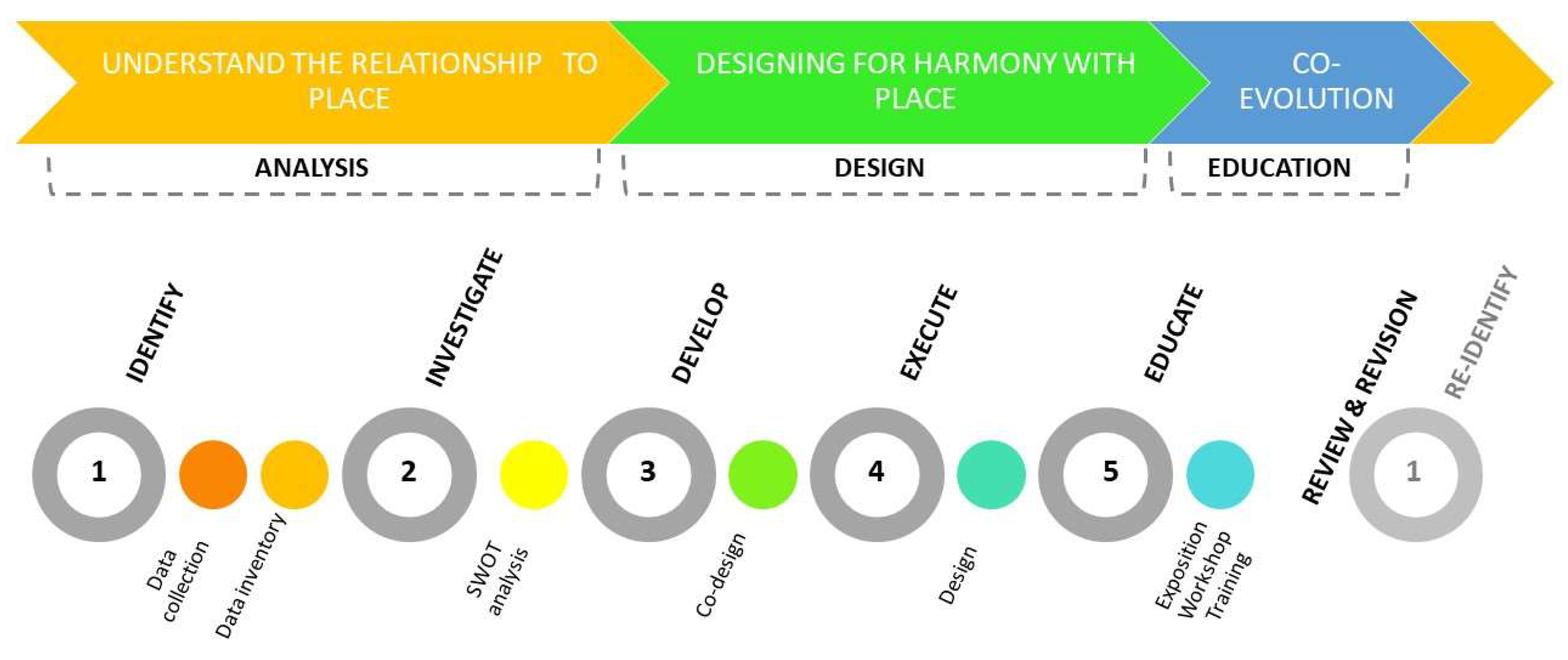


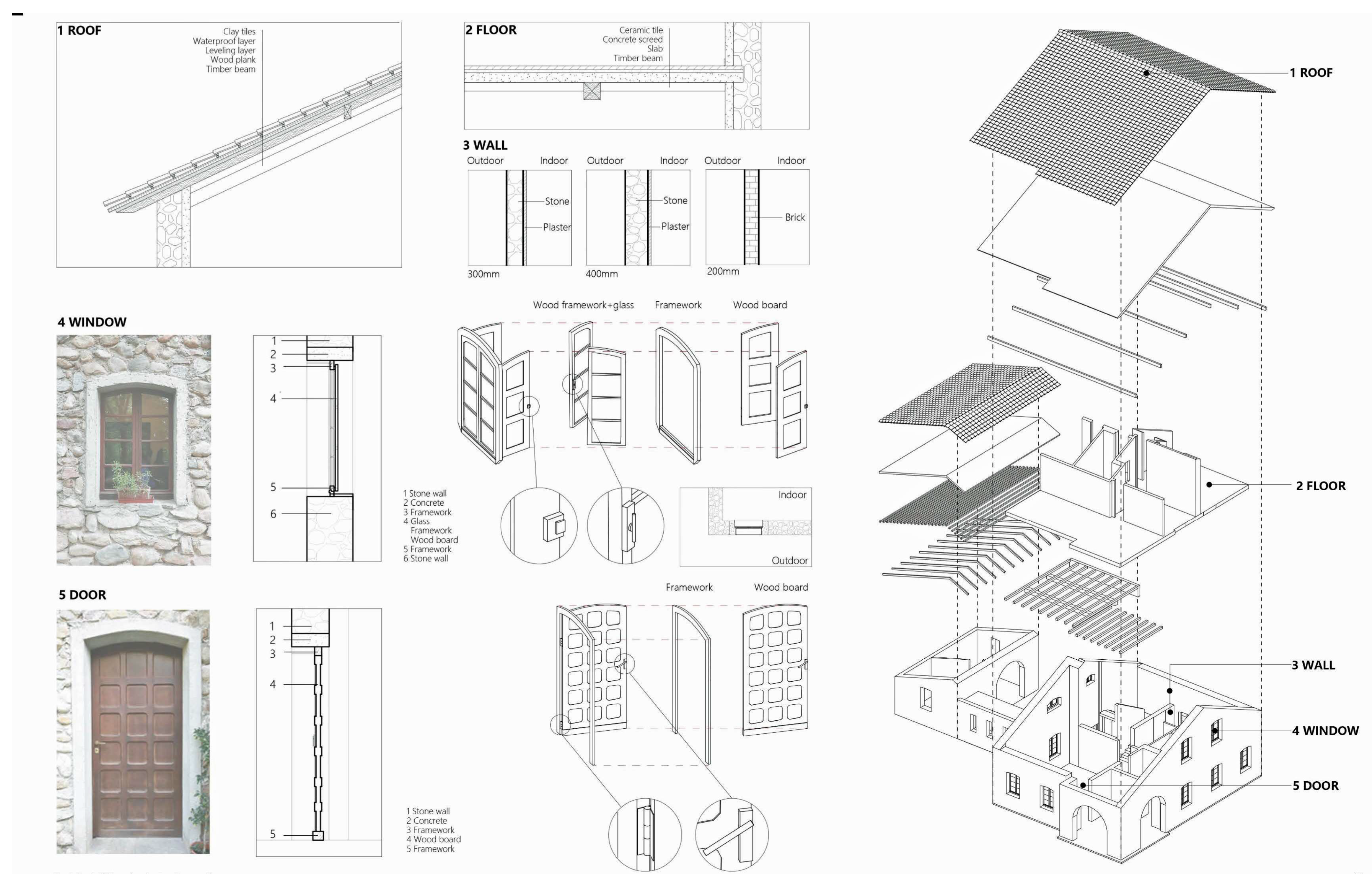


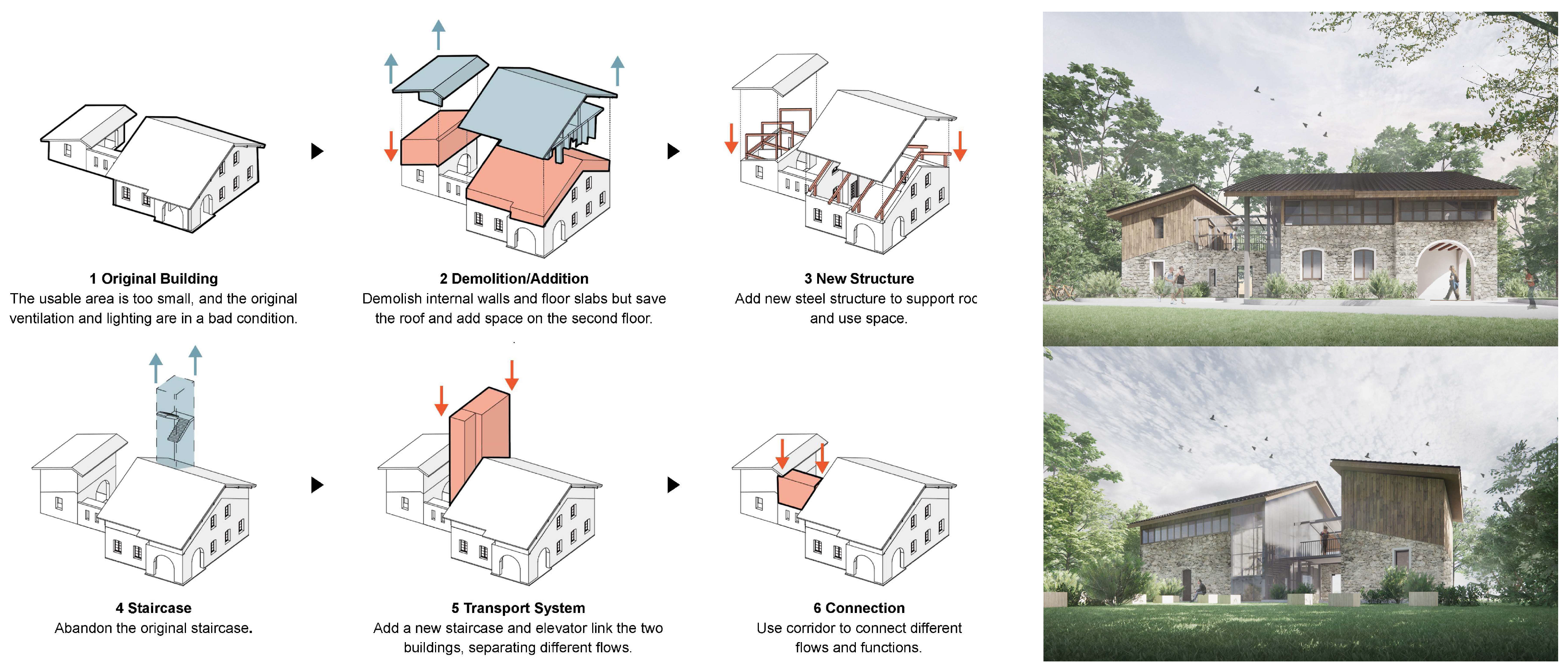

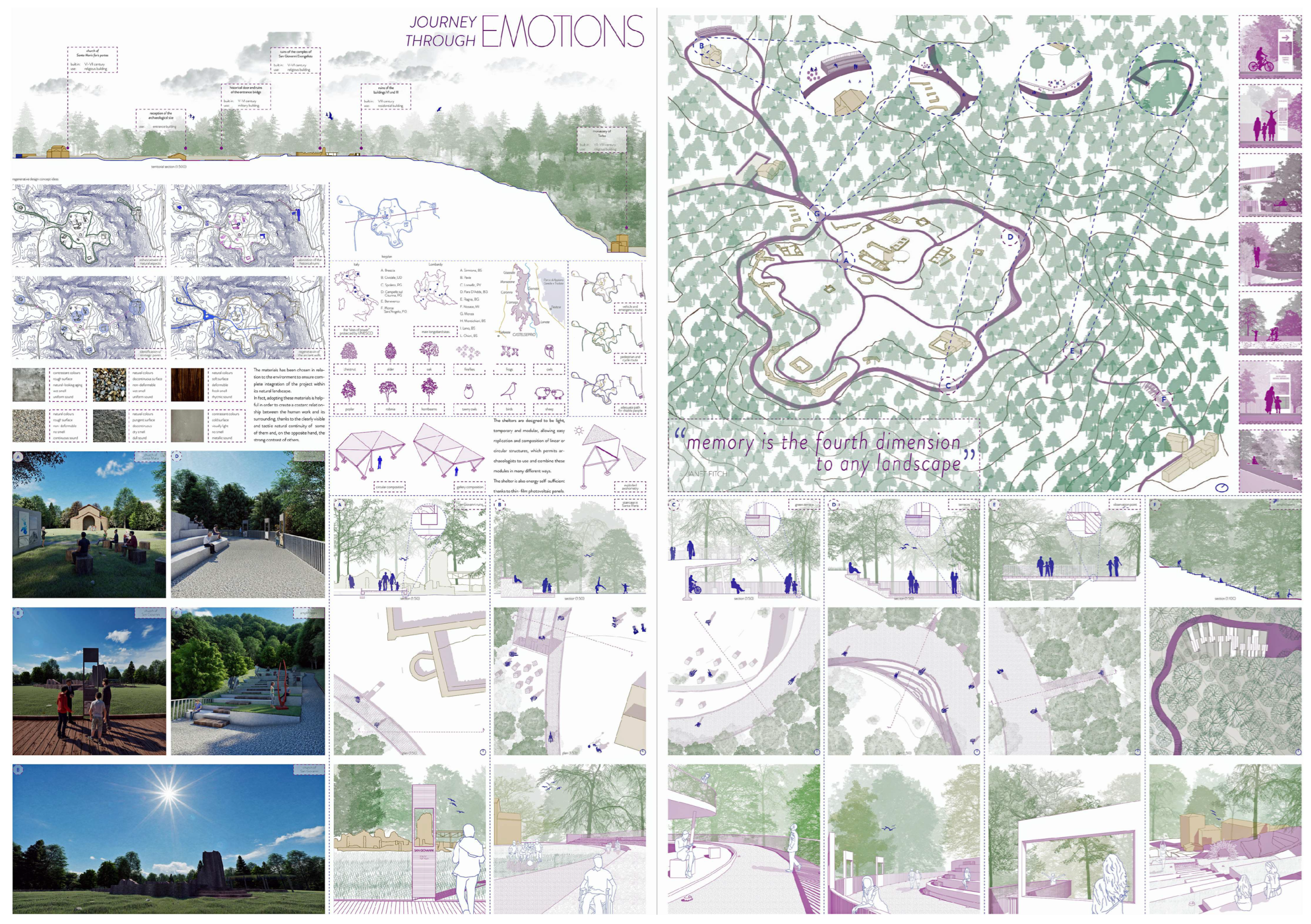
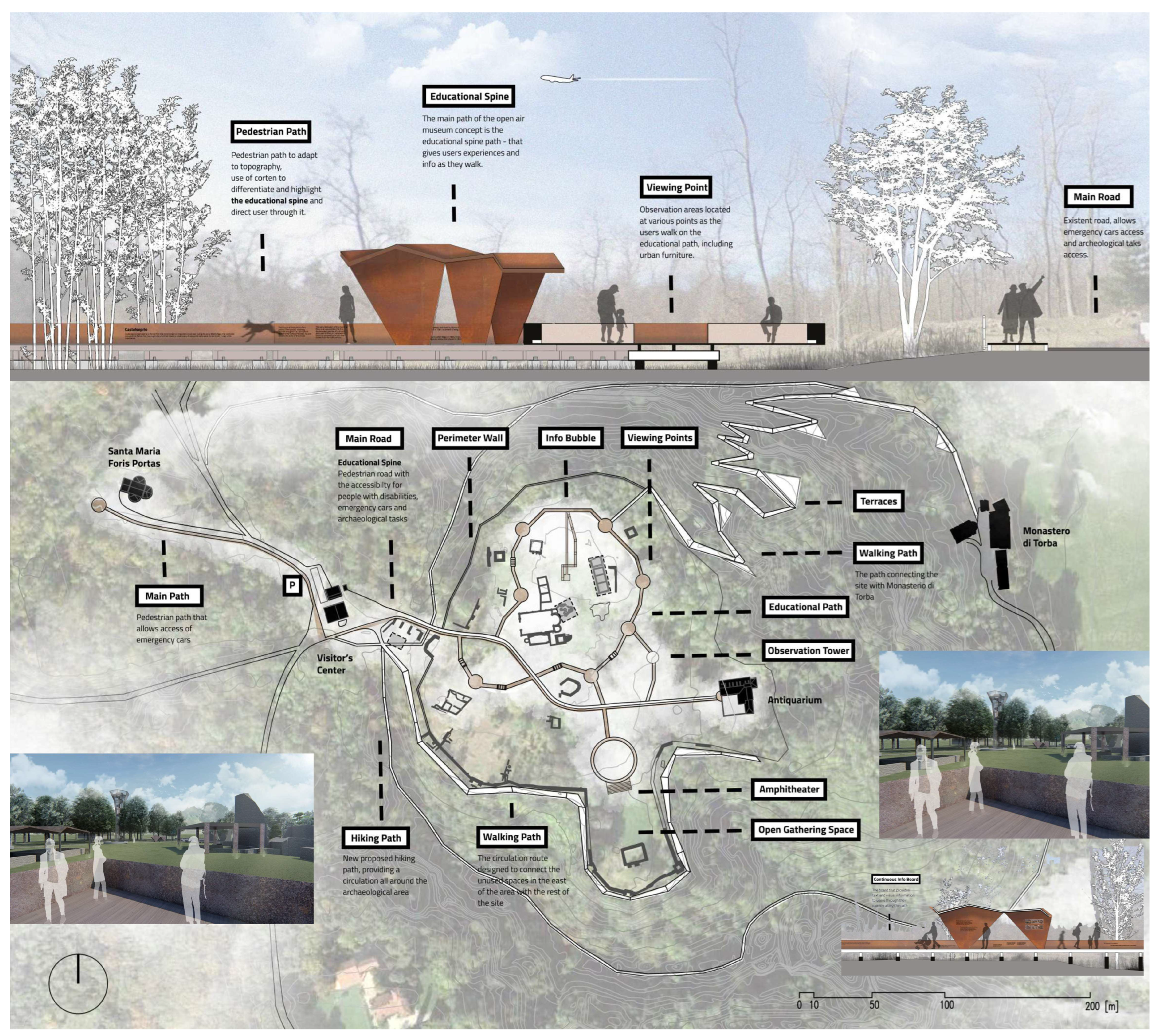
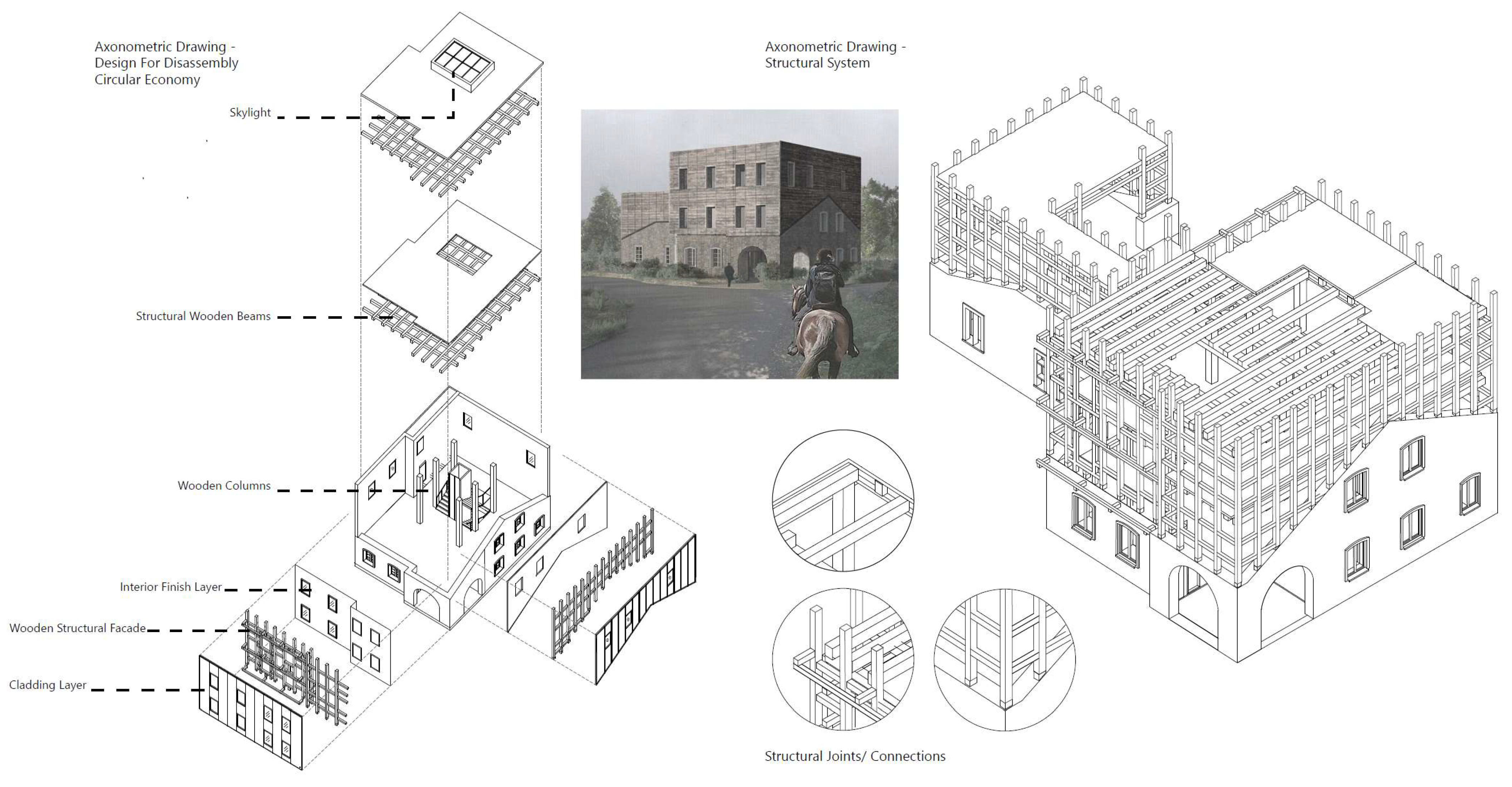
| Sustainable Aspect | Technique | Sources | Data Collected | Level | |
|---|---|---|---|---|---|
| Site | Building | ||||
| Heritage | Archival research | Heritage records Local inventories Historical books Catalogues of typical construction materials Archival documents Historical images | Age and construction period | ■ | ■ |
| Heritage values | ■ | ■ | |||
| Geometrical features | ■ | ■ | |||
| Architectural features | ■ | ■ | |||
| Materials, techniques, workmanship | - | ■ | |||
| History | ■ | ■ | |||
| Archaeologic character | ■ | ■ | |||
| Heritage-related legislation | ■ | ■ | |||
| Changes over the time | ■ | ■ | |||
| Integrity of design | ■ | ■ | |||
| Urban data analysis | Cartographic documentations | Heritage constrains | ■ | ■ | |
| Historical evolution | ■ | - | |||
| Grey literature analysis | Internet sites | Presence of heritage sites in the area | ■ | - | |
| Field investigation | Visual analysis Video and photos | Dimensions | ■ | ■ | |
| Structure | ■ | ■ | |||
| Materials and finishing | ■ | ■ | |||
| Constructive details | - | ■ | |||
| Materials, construction techniques | - | ■ | |||
| Patterns | ■ | ■ | |||
| Conservation level | ■ | ■ | |||
| Time degradation | ■ | ■ | |||
| Abandoned structures | ■ | ■ | |||
| Contextual inquiry | Field interviews | Community value | ■ | ■ | |
| Local identity perception | ■ | ■ | |||
| Management, conservation practices | ■ | ■ | |||
| Environment | Archival research | Heritage records Archival documents Historical images | Traditional flora and fauna | ■ | - |
| Historical land use | ■ | - | |||
| Historical urban grow | ■ | - | |||
| Urban data analysis | Cartographic documents Topographic maps Aerial photos Satellite images Land registers Building regulations Local archives Photographic documents | Location | ■ | ■ | |
| Site layout | ■ | - | |||
| Topography | ■ | - | |||
| Hydrology | ■ | - | |||
| Soil levels | ■ | - | |||
| Solar orientation | ■ | ■ | |||
| Heat island effect | ■ | ■ | |||
| Land uses | ■ | - | |||
| Urban-related legislation | ■ | ■ | |||
| Local planning criteria, provisions | ■ | ■ | |||
| Statistical data analysis | National database Local database | Microclimatic factors | ■ | ■ | |
| Energy labels | - | ■ | |||
| Traffic data | ■ | - | |||
| Contextual inquiry | Field interviews | Human comfort perception | ■ | ■ | |
| Spatial perception | ■ | ■ | |||
| Transportation systems | ■ | - | |||
| Statistical data analysis | National databases Local databases | Demographic profiles | ■ | - | |
| Number of tourists | ■ | ■ | |||
| Tourist fluxes | ■ | ■ | |||
| Grey literature analysis | Internet sites Newspapers Reports | Transport facilities | ■ | - | |
| Transport networks | ■ | - | |||
| Local parking | ■ | - | |||
| Field investigation | Visual analysis Video and photos | Transport functionality | ■ | - | |
| Travel time | ■ | - | |||
| Type of users | ■ | ■ | |||
| Type of activities | ■ | ■ | |||
| Interaction of activities | ■ | ■ | |||
| Compatibility of activities | ■ | ■ | |||
| People movements | ■ | ■ | |||
| Education level of heritage staff | ■ | ■ | |||
| Skills of heritage staff | ■ | ■ | |||
| Service, facility, amenity delivery | ■ | ■ | |||
| Urban data analysis | Land registers | Provision of new facilities | ■ | ■ | |
| Statistical data analysis | National databases | Economic data on tourism | ■ | ■ | |
| Employment, unemployment rates | ■ | ■ | |||
| Economic inactivity rates | ■ | - | |||
| Grey literature analysis | Internet sites Newspapers Social media Reports | Business location | ■ | - | |
| Local businesses | ■ | - | |||
| Town centers, commercial hubs | ■ | - | |||
| Economic wellbeing | ■ | - | |||
| Innovation level of the area | ■ | - | |||
| Field investigation | Visual analysis Video and photos | Local business | ■ | - | |
| Economic wellbeing | ■ | - | |||
| Contextual inquiry | Field interviews | Evaluation of actual tariffs | ■ | ■ | |
| Sustainability Heritage Environment Society Economy | 1. Competitive advantages 2. Resources 3. Well-performing aspects | 1. Disadvantages 2. Lack of resources 3. Underperforming aspects |
| Strengths | Weaknesses | |
| 1. Favorable external factors 2. Specific potentials 3. Specific possibilities | 1. External pressures 2. Potential harmful factors 3. Challenges | |
| Opportunities | Threats |
| Technique | Sustainable Aspect | Stakeholders Involved | Item Discussed | Level | |
|---|---|---|---|---|---|
| Site | Building | ||||
| Experience interview | Heritage | HA, archaeologists, heritage/museum staff, owner | Heritage constrains | ■ | ■ |
| Urban constrains | ■ | ■ | |||
| Conservation level | ■ | ■ | |||
| Materials, construction techniques | - | ■ | |||
| History | ■ | ■ | |||
| Chrono-mapping | ■ | ■ | |||
| Environment | Archaeologists, PA, HA, management staff, owner | Urban-related legislation | ■ | ■ | |
| Local planning criteria | ■ | ■ | |||
| Building-related codes | - | ■ | |||
| Functional plan | ■ | ■ | |||
| Use of natural resources | ■ | - | |||
| Signals and facilities | ■ | - | |||
| Equipment, furniture, services | ■ | ■ | |||
| Management procedures | ■ | ■ | |||
| Sustainability and energy policy | ■ | ■ | |||
| Waste/water management | ■ | ■ | |||
| Conservation level | ■ | ■ | |||
| Human comfort perception (staff) | ■ | ■ | |||
| Society | PA, HA, owner, community associations | Users’ perceptions | ■ | ■ | |
| Users’ needs | ■ | ■ | |||
| Economy | Owner, PA | Evaluation of management costs | ■ | ■ | |
| Sustainability | Strengths | Weaknesses | Opportunities | Threats |
|---|---|---|---|---|
| Heritage | High heritage values | Strict ruin protection | Providing a comfortable, welcoming, and friendly cultural environment | Heavy rains disturbing excavation process |
| Well-conserved archaeological site | Presence of abandoned buildings | |||
| UNESCO site | Inaccessible primary ruins and underway excavations | UNESCO World Heritage status will serve as a guideline | Badly maintained facilities | |
| Environment | High natural values | Not reasonable functions and distribution | Possibility of using renewable energy | Absence of sidewalk in the entrance way |
| Rich natural surroundings | Difficult to access by public transport | Possibility of using rainwater | Presence of wild animals have potential to damage ruins | |
| Insufficient parking | High solar potential | |||
| Well-conserved natural site | Onsite vehicle access diminishes the pedestrian experience | Enhance hiking and cycling activities by the creation of new routes | Prone to weather incidences (e.g., fallen trees) | |
| Multicolored biodiversity | High temperature conditions in summer season | Existing hiking trails can easily accept new trails | Separation of the site by height | |
| Proximity to local cycle path | Strong winds requiring high resistance objects | Presence of local cycle path to be continued | Steep landslide depriving water from the hill | |
| Important green area for local and regional biosystem | No facilities to reduce outdoor weather conditions | Strong winds enabling generating energy | Uneven landscape will prove challenging for disabled/elderly accessibility | |
| Ground surface not absorbing water | Excavated soil and stones to be reused | |||
| Society | Already known by the community | Absence of signals and touristic information | Remark the visual memory of the site | Balance between staff and visitor needs |
| Lack of touristic organization | Religious presence on site | |||
| Sense of loss inside the site | ||||
| Some areas are unknown/missed | Provide the community a space for activities/events | Users causing damage to the archaeological site or ruins | ||
| Different protection levels across the site | ||||
| Difficulty of movement of people with disabilities | ||||
| Economy | Famous archaeological site | Lack of funding | Potential economy values | - |
| Easy to be promoted | Potential large flows of people | |||
| Important heritage site |
| Sustainability | Strengths | Weaknesses | Opportunities | Threats |
|---|---|---|---|---|
| Heritage | High heritage and historical values | - | Presence of several historic documents | Connection between historic and new constructions |
| Vernacular aesthetics | High flexibility for building renovation | Conservation of the historic values | ||
| UNESCO site | ||||
| Environment | Information building located at the entrance of the site | Not reasonable functions and distribution | Build an extension to provide space for activities | Upgrade of the energy and environmental performances |
| Poor spatial organization | Building accessibility | |||
| Presence of an available courtyard | Not friendly and welcoming building | Introduction of new functions | Improvement of the spatial quality | |
| Absence of indoor natural ventilation | ||||
| Adequate energy performance of building masonries | High temperature and relative humidity inside the building | Adoption of passive strategies for energy retrofit | Building positioned between trees (possible construction and maintenance problems) | |
| Poor indoor hygrothermal, visual, and acoustic comfort | ||||
| Well-conserved information building | Low energy performance of windows | Bioclimatic and biophilic design | Materials not suitable for recycling | |
| Short service life | ||||
| High carbon emission | ||||
| Waste of water | ||||
| Society | - | Lack of space for archaeologists and for learning activities | Introduction of new functions according to users’ needs | Balance between staff and visitor needs |
| Architectural barriers | ||||
| Economy | Large flow of people | - | - | - |
| Design Keywords | Key-Design Principles | |
| Before Co-Design Experience | After Co-Design Experience | |
 | 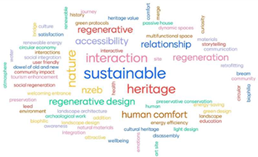 | |
| Regeneration | Regenerative | Regenerative design |
| Eco | Regeneration | |
| Social regeneration | ||
| Sustainable | Sustainable | |
| Awareness | ||
| Reuse | Cultural heritage | Heritage conservation, enhancement, and management |
| Archaeological work | ||
| History | ||
| Culture | ||
| Preservation | ||
| Heritage value | ||
| Conservation | ||
| Flexible | Dynamic spaces | Flexibility and adaptability |
| Multifunctional space | ||
| Affordance | Addition | Reversibility and recognizability |
| Merge | ||
| Bridge | ||
| Biophilia design | Biophilic | Biophilia and landscape design |
| Landscape architecture | ||
| Landscape design | ||
| Green design | ||
| Art site | ||
| - | Environment | Environmental and water preservation |
| Site | ||
| Water | ||
| - | Accessibility | Accessibility and universal design |
| Circular | Natural materials | Natural materials and circular economy |
| Circular economy | ||
| Circular | ||
| Disassembly | ||
| Efficient | Retrofitting | Deep energy retrofit |
| Passive house | ||
| Energy saving | ||
| Renewable | Renewable energy | Renewable energy |
| Comfort | Comfort | Human comfort and wellbeing |
| Climate | Health | |
| Wellness | Wellbeing | |
| Interaction | Interactions | Emotional design |
| Interactive | Interactive | |
| Humanization | Relationships | |
| Emotion | Emotions | |
| Atmosphere | Atmosphere | |
| Sensory suggestion | Community | User-centered design |
| Community impact | ||
| Communication | ||
| Education | ||
| Curiosity | ||
| User-friendly | ||
| - | Journey | Open-air architectural park |
| Storytelling | ||
| Attractive | ||
| Green Protocols | Green protocols | Green rating systems |
| LEED | ||
| BREAM | ||
Disclaimer/Publisher’s Note: The statements, opinions and data contained in all publications are solely those of the individual author(s) and contributor(s) and not of MDPI and/or the editor(s). MDPI and/or the editor(s) disclaim responsibility for any injury to people or property resulting from any ideas, methods, instructions or products referred to in the content. |
© 2023 by the author. Licensee MDPI, Basel, Switzerland. This article is an open access article distributed under the terms and conditions of the Creative Commons Attribution (CC BY) license (https://creativecommons.org/licenses/by/4.0/).
Share and Cite
Lucchi, E. Regenerative Design of Archaeological Sites: A Pedagogical Approach to Boost Environmental Sustainability and Social Engagement. Sustainability 2023, 15, 3783. https://doi.org/10.3390/su15043783
Lucchi E. Regenerative Design of Archaeological Sites: A Pedagogical Approach to Boost Environmental Sustainability and Social Engagement. Sustainability. 2023; 15(4):3783. https://doi.org/10.3390/su15043783
Chicago/Turabian StyleLucchi, Elena. 2023. "Regenerative Design of Archaeological Sites: A Pedagogical Approach to Boost Environmental Sustainability and Social Engagement" Sustainability 15, no. 4: 3783. https://doi.org/10.3390/su15043783
APA StyleLucchi, E. (2023). Regenerative Design of Archaeological Sites: A Pedagogical Approach to Boost Environmental Sustainability and Social Engagement. Sustainability, 15(4), 3783. https://doi.org/10.3390/su15043783






